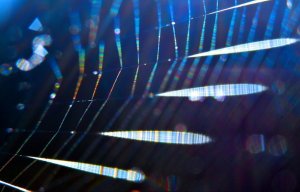
Searching for the battleship steel version of spider silk
Genetically engineered bacteria creates hybrid polymeric amyloid protein with 128 repeating units.

23rd August 2021
Innovation in Textiles
|
St Louis, MI, USA
Engineers at Washington University in St. Louis have produced amyloid silk hybrid proteins and turned them into fibres that are stronger and tougher than some natural spider silks.
To be precise, the artificial silk – dubbed ‘polymeric amyloid’ fibre – was not technically produced by the researchers, but by the bacteria that was genetically engineered in the lab of Fuzhong Zhang, a professor in the Department of Energy, Environmental and Chemical Engineering in the McKelvey School of Engineering.
In 2018, Zhang’s lab engineered bacteria that produced a recombinant spider silk with performance on par with its natural counterparts in all of the important mechanical properties.
“After our previous work, I wondered if we could create something better than spider silk using our synthetic biology platform,” he said.
The research team modified the amino acid sequence of spider silk proteins to introduce new properties, while retaining some of the attractive features of spider silk.
β-nanocrystals
A problem associated with recombinant spider silk fibre – without significant modification from the natural spider silk sequence – is the need to create β-nanocrystals, a main component of natural spider silk, which contributes to its strength.
“Spiders have figured out how to spin fibres with a desirable amount of nanocrystals, but when humans use artificial spinning processes, the amount of nanocrystals in a synthetic silk fibre is often lower than its natural counterpart,” Zhang said.
To solve this problem, the team redesigned the silk sequence by introducing amyloid sequences that have high tendency to form β-nanocrystals. Different polymeric amyloid proteins were created using three well-studied amyloid sequences as representatives. The resulting proteins had less repetitive amino acid sequences than spider silk, making them easier to be produced by engineered bacteria.
128 repeating units
Ultimately, the bacteria produced a hybrid polymeric amyloid protein with 128 repeating units. The recombinant expression of spider silk protein with similar repeating units has previously proved to be difficult.
The longer the protein, the stronger and tougher the resulting fibre. The 128-repeat proteins resulted in a fibre with gigapascal strength – a measure of how much force is needed to break a fibre of fixed diameter – stronger than common steel. In addition, the fibre is tougher than Kevlar and all previous recombinant silk fibres. Its strength and toughness are even higher than some reported natural spider silk fibres.
It has subsequently been confirmed that the high mechanical properties of the polymeric amyloid fibres do come from the enhanced amount of β-nanocrystals.
“This demonstrates that we can engineer biology to produce materials that beat the best material in nature,” Zhang said. “This work explored just three of thousands of different amyloid sequences that could potentially enhance the properties of natural spider silk. There seem to be unlimited possibilities in engineering high-performance materials using our platform.”

Business intelligence for the fibre, textiles and apparel industries: technologies, innovations, markets, investments, trade policy, sourcing, strategy...
Find out more